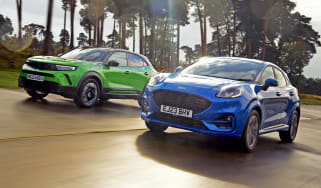Ford Puma review: an entertaining small SUV
The Ford Puma is a stylish, practical compact SUV that’s good to drive, but rivals have a higher-quality cabin (for now)

After a number of misses for the American brand in the small SUV class, the Ford Puma has struck gold. It has succeeded because it gives people an attractive blend of practicality and affordability, without compromising on the fun-to-drive dynamics of the Fiesta upon which it was based, all while offering strong equipment levels. And it seems buyers agree, since the Puma is one of the UK’s best-selling cars.
Sure, there are rivals that offer a more upmarket-feeling interior (an issue that might be fixed when the Puma is updated later in 2024), and some offer greater boot space, but virtually none can outshine this little Ford from behind the wheel, and it’s a massive improvement over the lacklustre EcoSport it replaced.
About the Ford Puma
Some of you may remember that back in 1997, Ford launched a fun, small, front-wheel-drive coupe called the Ford Puma. It was based on what was then the fourth-generation Fiesta, and added some badly needed desirability to the brand’s UK line-up. It was only a hit for a short while (lasting until 2002), because buyers were quickly shifting away from impractical coupe body styles.
Now, the Puma name is back, and it’s an extremely similar story save for one very important detail; the new Ford Puma is not a small coupe, but a small five-door SUV. It’s based on the seventh-generation Fiesta supermini (that has now sadly ceased production), sharing its chassis and its engines. There are no plans to axe the Puma, however, and an electric version is even in the pipeline to help it compete in a very crowded sector of the market.
Chief rivals for the Ford Puma include the Renault Captur, the Peugeot 2008, Skoda Kamiq and SEAT Arona, while the handsome Mazda CX-30 and spacious Volkswagen T-Cross offer further possibilities for customers considering a small family SUV. Left-field alternatives include cars like the design-led Nissan Juke, chunky Jeep Avenger and Jeep Renegade, plus the retro-looking Fiat 500 X.
More reviews
Car group tests
- Ford Puma vs Vauxhall Mokka: two best-selling crossovers clash
- Hyundai Kona N vs Ford Puma ST: 2022 twin test review
In-depth reviews
Long-term tests
Road tests
Used car tests
The Puma trim structure is fairly straightforward with four core versions: Titanium, ST-Line, ST-Line X and luxury ST-Line Vignale. There's also a Vivid Ruby Edition model offered at the time of writing, while the Puma ST performance model sits at the top of the range. Puma ST buyers can also upgrade to the ST Performance Pack, which includes a limited slip differential and a launch control function.
The Titanium trim is very well equipped with 17-inch alloy wheels, LED rear lights and daytime running lights, body-coloured exterior trim, power-folding heated mirrors, rear parking sensors and selectable drive modes.
ST-Line models include a muscular body-kit, sports suspension, a leather sports steering wheel and alloy pedals, while ST-Line X cars come with stylish 18-inch wheels, privacy glass, a wireless charging pad for your smartphone and a 10-speaker Bang & Olufsen sound system. The Vignale version ups the luxury count with heated seats, a heated steering wheel, front parking sensors and keyless entry, while the ST car features 19-inch alloy wheels, a body styling kit, Ford Performance seats and more power.
The Puma is front-wheel-drive only, and buyers are offered three petrol engine options. The EcoBoost 125 employs a 123bhp 1.0-litre turbocharged three-cylinder unit; using 48-volt mild-hybrid technology it brings a slight increase in torque over the previous non-hybrid model, with marginal reductions in CO2 emissions and gains in fuel economy, too. A second option is another version of the 1.0-litre three-cylinder turbocharged petrol with the same mild-hybrid system, but power is pushed up to 153bhp.
For the performance enthusiast, the Puma ST is arguably the best-handling small SUV on sale, powered by 197bhp 1.5-litre engine, while a new 168bhp 1.0-litre version is also available with an automatic 'box.
A six-speed manual gearbox is standard across the Puma range, with an optional seven-speed automatic transmission. If you want the 153bhp version with an auto 'box, you'll have to specify the top-spec ST-Line Vignale or Vivid Ruby Edition, while the racy ST now includes a new 168bhp auto variant.
Ford Puma ST-Line: long-term test
Senior photographer, Pete Gibson, put almost 30,000 miles on a 1.0 mHEV 155 ST-Line back in 2021. Pete really enjoyed his time behind the wheel, often finding the Puma to be more impressive on the road than some of the high-end performance cars he was snapping at various shoots.
He found having a washable box under the boot floor a big help when dealing with his children’s muddy shoes, while there was enough space to store all his camera gear. However, a larger fuel tank would’ve been welcome, and the interior quality could have been better, with a broken parcel shelf occurring on his first outing with the car.
For an alternative guide to the Ford Puma, visit our sister site carbuyer.co.uk...
Frequently Asked Questions
Which Is Best
Cheapest
- Name1.0 EcoBoost Titanium 5dr
- Gearbox typeManual
- Price£20,415
Most Economical
- Name1.0 EcoBoost Titanium 5dr
- Gearbox typeManual
- Price£20,415
Fastest
- Name1.5 EcoBoost ST 5dr
- Gearbox typeManual
- Price£31,435


























